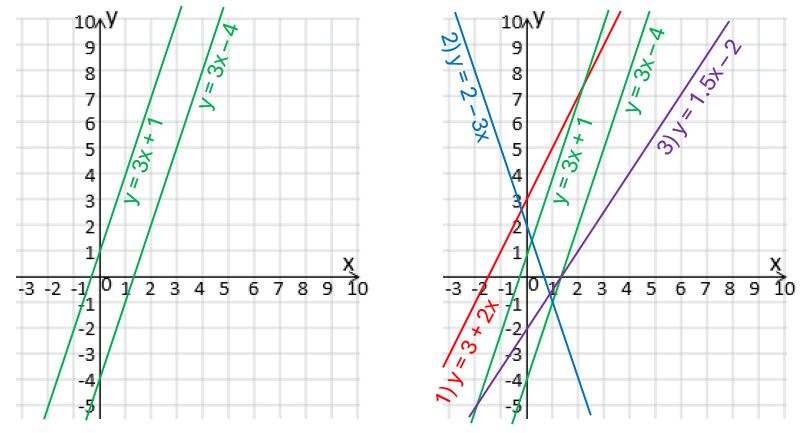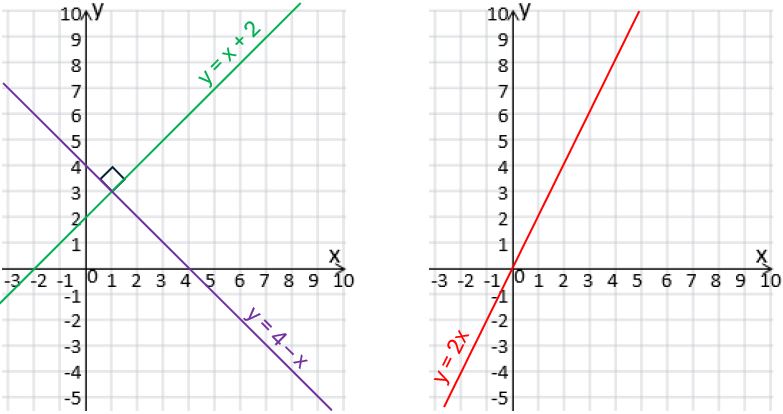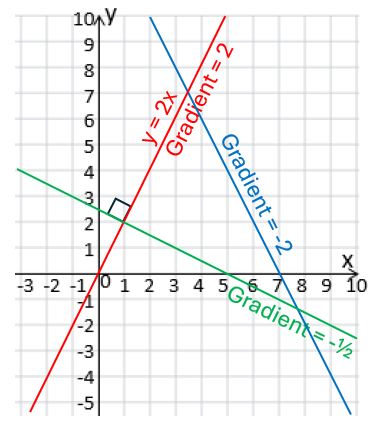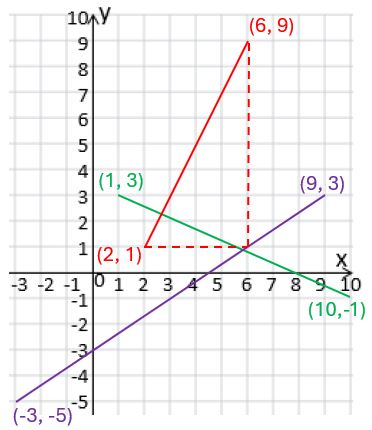Straight line graphs Part 3
This is the final instalment of my series of tutorials on straight line graphs, and follows on from “Working with a coordinate grid“, “Straight line graphs Part 1” and “Straight line graphs Part 2“. We’ve covered most of the Foundation Tier material – the only bits left to do are parallel lines and the mid-point of a line – and will also cover the Higher Tier content here.
There are some activities to work through in this tutorial, with the answer to each step given if you scroll down a little, so for maximum benefit, try to do each part before you scroll down and reveal the answer.
Recap of key points covered so far
Part 1 recap
A graph is a picture showing the relationship between two algebraic variables – we usually use x going across and y going up, but any letters can be used.
A line with the equation x = k (where k is a constant) will always be vertical and will cross the x-axis at k.
A line with the equation y = k will always be horizontal and will cross the y-axis at k.
If the equation of a straight line graph is given in the form y = mx + c then
- The c (the number on its own) is the y-intercept, i.e. the number on the y-axis where the graph crosses it.
This is also the value of y when x is 0, since any graph crosses the y-axis when x = 0 (and vice versa). - The m (the number multiplied by the x) is the gradient, i.e. how many units the graph goes up by, for each unit to the right. (The x is not part of the gradient!)
If you have these two pieces of information then you can plot, or sketch, a straight line graph without always having to make a table of values and plot all the points.
For example, line y = 2x + 3 will cross the y-axis at 3 and will have a gradient of 2, i.e. it goes up 2 units for every 1 unit to the right.
And the line y = 1 – 4x can be thought of as y = -4x + 1, so it crosses the y-axis at 1 and has a gradient of -4, i.e. it goes DOWN 4 units for every 1 to the right.
Part 2 recap
You can find the gradient of a straight line graph by taking any two points on the graph and using the formula ![]() or
or ![]() .
.
You can find the equation of any straight line graph if you know its gradient m and a point (x, y) on the line, by substituting the values of y, x, and m into the equation y = mx + c and then solving the equation to find the value of c.
To sketch a straight line graph, draw a set of axes with no numbers and show only the numbers that are important. For example the graph y = 2x + 3 crosses the y-axis at 3, so you mark that in, and has a gradient of 2, so you draw a line that goes through 3 on the y-axis and has a fairly steep upward slope from left to right.
If you need the x-intercept then put y = 0 and solve to find x.
If the equation is given in the form ax + by = k, you can use the cover-up method: Put x = 0 so the x-term disappears and see what that leaves you with for the y-intercept, then put y = 0 to find the x-intercept in the same way.
Sometimes you need to rearrange the equation to make it look like y = mx + c so that you can find the gradient and y-intercept.
Now on to the new content…
Parallel and perpendicular lines
Parallel lines (Foundation/Higher)
If two lines have the same gradient then they are parallel.
For example, y = 3x + 1 and y = 3x – 4 are parallel, because they both have a gradient of 3.
But these lines are NOT parallel to the previous two – can you say why?
- y = 3 + 2x
- y = 2 – 3x
- 2y = 3x – 4
Answers:
- The gradient is 2 (the 3 here is the y-intercept)
- The gradient is -3 so this graph goes down from left to right
- This isn’t in the form y = mx + c; to get it into that form you need to divide through by 2 to get y =
 x – 2, so the gradient is
x – 2, so the gradient is  or 1.5, not 3.
or 1.5, not 3.
Look at the diagram below to see what the five straight line graphs look like. The two parallel ones are shown in green and then the others are added. You can see that none of the later ones are parallel.

Example problem:
Find the equation of the line parallel to y = 4x – 5 that passes through the point (2, 7).
Solution:
If the line is parallel to y = 4x – 5 then it must have the same gradient, i.e. m = 4.
We already know how to find the equation of a line when we know the gradient and a point on the line:
At (2, 7), x = 2 and y = 7. Substitute these and m = 4 into the equation y = mx + c:
7 = 4×2 + c
then solve to find the value of c:
7 – 8 = c
c = -1
So the equation of the line is y = 4x – 1.
Your turn 1
- Find the equation of the line parallel to 2x + y = 4 that crosses the y-axis at -5.
- Find the equation of the line parallel to x – 2y = 6 that passes through (-2, 4).
Perpendicular lines (Higher only)
Perpendicular lines meet each other at right angles.
On the first set of axes below, we have the straight line graphs of y = x + 2 and y = 4 – x (or y = -x + 4). You can see that, when they cross, the angle between them is a right angle. The 2 and the 4 in the equations are irrelevant here; it’s only the gradients that we are interested in.
So we can see that a line with a gradient of 1 is perpendicular to a line with a gradient of -1.

Now look at the red line, y = 2x, on the second set of axes. You can see that it has a gradient of 2. What would the gradient be of the line perpendicular to this one?
Hint: It’s not -2!
Answer:
Since the red line has a positive gradient, i.e. goes up from left to right, any straight line graph that is perpendicular to it will have to have a negative gradient.
The red line goes up by 2 for every 1 across, so the perpendicular line needs to go down by 1 for every 2 across; in other words, it has a gradient of -½.
The image below shows you the original red line with gradient 2, together with lines of gradient -2 (blue, not perpendicular) and -½ (green, perpendicular).

If you think of the gradients as fractions then it makes it easier to see the relationship:
A gradient of ![]() is perpendicular to a gradient of
is perpendicular to a gradient of ![]() .
.
A gradient of ![]() is perpendicular to a gradient of
is perpendicular to a gradient of ![]() .
.
What gradient do you think would be perpendicular to a gradient of ![]() ?
?
Try to work it out before you scroll any further!
…
…
Did you say ![]() ? If so then well done!
? If so then well done!
In general, we say that one gradient is the negative reciprocal of the other, or that the product of two perpendicular gradients is -1.
Have a look:![]()
![]()
![]()
If ![]() then
then ![]()
So if ![]() then
then ![]() , or the negative reciprocal of
, or the negative reciprocal of ![]() .
.
Example problem:
Find the equation of the line perpendicular to y = 4x – 5 that passes through the point (8, 7).
Solution:
If the line is perpendicular to y = 4x – 5 (which has gradient m₁ = 4) then its gradient must be -¼, so m₂ = -¼.
At (8, 7), x = 8 and y = 7. Substitute these and m₂ = -¼ into the equation y = m₂x + c:
7 = -¼×8 + c = -2 + c
then solve to find the value of c:
7 + 2 = c
c = 9
So the equation of the line is y = -¼ x + 9.
Your turn 2
- Find the equation of the line perpendicular to 2x + y = 4 that crosses the y-axis at -5.
- Find the equation of the line perpendicular to 2x – 3y = 6 that passes through (6, -1).
Alternative form of straight line equation:
y – y₁ = m(x – x₁) (Higher only)
If you go on to do A-level then you’ll probably use this form of the straight line graph equation a lot. Depending on where you’re trying to get to, it can be easier to use than y = mx + c.
y – y₁ = m(x – x₁) is just another way of describing a straight line graph, where m is the gradient and (x₁, y₁) is any point that you know is on the line. If you know two points on the line then it doesn’t matter which one you use.
Let’s look again at the earlier example with parallel lines: Find the equation of the line parallel to y = 4x – 5 that passes through the point (2, 7).
We know that the gradient is 4, and the known point on the line is (2, 7) so that’s our (x₁, y₁).
Simply substitute these values into the new formula, and – provided that the question doesn’t ask for the equation to be given in a particular form – you’re done; no need to find c!
So y – y₁ = m(x – x₁) simply becomes
y – 7 = 4(x – 2).
Of course, you can rearrange this into y = mx + c form if you want to know the y-intercept. Try it and check that you get the same answer as before, i.e. y = 4x – 1.
Similarly, with the perpendicular lines example – Find the equation of the line perpendicular to y = 4x – 5 that passes through the point (8, 7) – we have a perpendicular gradient of -¼ and a known point on the line of (8, 7) so we get
y – 7 = -¼(x – 8)
which can be rearranged to y = -¼ x + 9
Now try the questions from “Your turn 1” and “Your turn 2” again, using this version of the equation.
Mid-point of a line (Foundation/Higher)
In the diagram below, you can see three line segments. (A line segment is just a section of a line that has a finite length; a line, in theory, goes on for ever.)
Look at the red one, which has end points (2, 1) and (6, 9). Can you think of a way to work out the coordinates of the mid-point of that line? (Don’t rely on counting squares on the grid – you won’t always be able to do that!)

The x-coordinates of the end points are 2 and 6, so the x-coordinate of the mid-point is going to be mid-way between those two values. What’s the simplest way to find the value exactly half way in between a pair of values?
Just find the mean: add them together and divide by 2!
(You can also start from the bottom one and add on half the difference between the two – that’s often the approach that my students suggest at first; it will get you there, but finding the mean is simpler.)
So we get x = ![]()
And of course we do the same thing with the y-coordinates, 1 and 9: y = ![]()
So the mid-point of the red line is (4, 5).
In general, the mid-point of a line segment with end points (x₁, y₁) and (x₂, y₂) is
(mean x, mean y) or ![]() .
.
Your turn 3
Find the coordinates of the mid-points of the line segments with end points
- (-3, -5) and (9, 3) (shown in purple on the grid above)
- (1, 3) and (10, -1) (shown in green on the grid above)
- (-2, 4) and (20, -7)
Length of a line segment (Higher only)
Here’s the same grid again that we used in the last section. This time we’re going to find the length of the red line segment, using the coordinates of its end points, (2, 1) and (6, 9). Can you think how we might do that?

The answer is that we use Pythagoras’ theorem. The line segment itself is the hypotenuse of a right-angled triangle, with dotted lines showing the two shorter sides.
The horizontal side goes from 2 to 6 on the x-axis, so that’s a length of 6 – 1 = 4.
The vertical side goes from 1 to 9 on the y-axis, so that’s a length of 9 – 1 = 8.
So (length of line segment)² = 4² + 8² = 16 + 64 = 80
giving a length of √80 or approx. 8.94 units.
Your turn 4
Find the lengths of the line segments with end points
- (-3, -5) and (9, 3) (shown in purple on the grid above)
- (1, 3) and (10, -1) (shown in green on the grid above)
- (-2, 4) and (10, -5)
Finding the equation of a perpendicular bisector
We’ve now covered all the skills you need to work with straight line graphs. Let’s try an application that puts some of them to use!
First, can you explain what a perpendicular bisector is?
…
…
It’s a line that cuts another line exactly in half by crossing it at right angles.
Your challenge is to find the equation of the perpendicular bisector of line segment AB, shown on the graph below, where A is the point (-1, -2) and B is (3, 8).
Give your answer in the form px + qy = r, where p, q and r are all integers.
First, try to predict what skills you are going to need, then scroll down to see if you were right.

If the new line crosses AB at right angles then we need the perpendicular gradient. But to work that out, we first need to find the gradient of AB.
If it cuts AB exactly in half then it will cross at its midpoint so we need to find those coordinates.
Finally, we need to plug the information we’ve got into the straight line equation and rearrange it into the required form.
Now see if you can do it, before you scroll down to see the solution.
Solution
Gradient of AB = ![]()
So perpendicular gradient = ![]()
Mid-point = (mean x, mean y) = ![]() = (1, 3)
= (1, 3)
So the perpendicular bisector has gradient ![]() and goes through (1, 3)
and goes through (1, 3)
Substitute into y – y₁ = m(x – x₁):
y – 3 = ![]() (x – 1)
(x – 1)
(Of course you could use y = mx + c but then you’d have to work out the c, and after that you’d have to rearrange it anyway to get into the required form.)
If the question hadn’t stipulated a particular form for the answer (the wording in that case is usually “Find an equation for…”) then what we’ve already done would be enough for full marks, but in this case we need to rearrange it into the required form.
Multiply both sides by 5 to get rid of the fraction:
5(y – 3) = -2(x – 1)
Expand brackets:
5y – 15 = -2x + 2
Get the xs and ys on one side and gather the constants on the other:
2x + 5y = 17
… and we’re done!
Of course, it’s a good idea to check your answer. This format makes it easy to find the x- and y-intercepts of the new line (using the cover-up method); what are they?
Answer: 2x = 17 so x = 8.5; 5y = 17 so y = 3.4
If we draw that line in on the grid it looks like this. You can see that it crosses AB at its mid-point and at right angles.

That covers everything you need to know about straight line graphs, for both GCSE/IGCSE and A-level.
If you’ve found this article helpful then please share it with anyone else who you think would benefit (use the social sharing buttons if you like). If you have any suggestions for improvement or other topics that you’d like to see covered, then please comment below or drop me a line using my contact form.
On my sister site at at mathscourses.co.uk you can find – among other things – a great-value suite of courses covering the entire GCSE (and Edexcel IGCSE) Foundation content, and the “Flying Start to A-level Maths” course for those who want to get top grades at GCSE and hit the ground running at A-level – please take a look!
If you’d like to be kept up to date with my new content then please sign up to my mailing list using the form at the bottom of this page, which will also give you access to my collection of free downloads.
Your turn 1 – answers
1) Original equation rearranges to y = -2x + 4 so m = 4. y-intercept c = -5 so the new equation is y = -2x – 5.
2) Original equation rearranges to y = ½ x – 3 so m = ½. Sub that and (-2, 4) into y = mx + c to get 4 = ½×-2 + c = -1 + c so c = 4 + 1 = 5, so the new equation is y = ½ x + 5.
Click here to return to questions
Your turn 2 – answers
- m₁=-2 so m₂=½; c = -5 so equation is y = ½ x – 5
- m₁=⅔ so m₂=-3/2 or -1.5; Sub in with (6, -1) to get -1 = -1.5 × 6 + c => c = -1 + 9 = 8, so the new equation is y = -1.5x +8
Click here to return to questions
Your turn 3 – answers
- (3, -1)
- (5.5, 1)
- (9, -1.5)
Click here to return to questions
Your turn 4 – answers
- Short sides are 12 and 8 so length is √208 (or 14.4)
- Short sides are 9 and 4 so length is √97 (or 9.85)
- Short sides are 12 and 9 so length is √225 = 15 (this is a Pythagorean triple)

